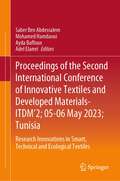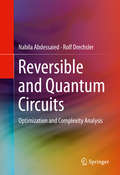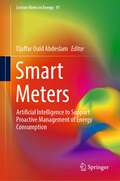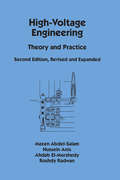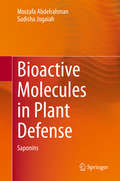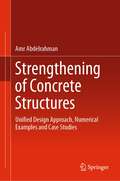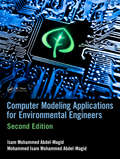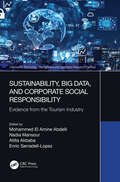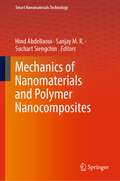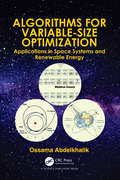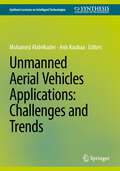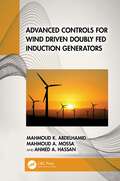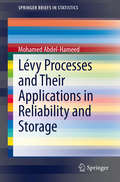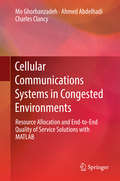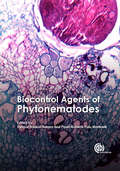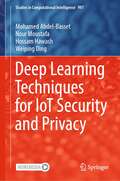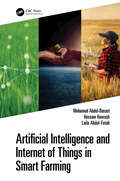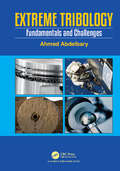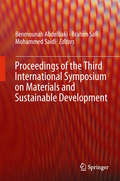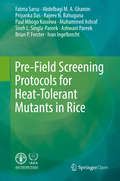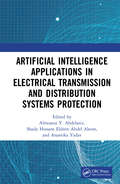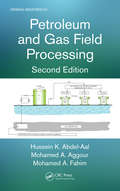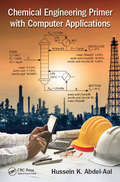- Table View
- List View
Proceedings of the Second International Conference of Innovative Textiles and Developed Materials-ITDM’2; 05-06 May 2023; Tunisia: Research Innovations in Smart, Technical and Ecological Textiles
by Saber Ben Abdessalem Mohamed Hamdaoui Ayda Baffoun Adel ElamriThis book includes selected articles from the 2nd International Conference on Innovative Textiles and Developed Materials (ITDM’2) held in Monastir, Tunisia, on May 5 and 6, 2023. The articles present latest scientific concepts and technological advances in innovative and sustainable textile materials and processes worldwide. The conference promotes exchange of ideas and emerging technologies to foster collaboration between academia and industry.
Reversible and Quantum Circuits
by Nabila Abdessaied Rolf DrechslerThis bookpresents a new optimization flow for quantum circuits realization. At thereversible level, optimization algorithms are presented to reduce the quantumcost. Then, new mapping approaches to decompose reversible circuits to quantumcircuits using different quantum libraries are described. Finally, optimizationtechniques to reduce the quantum cost or the delay are applied to the resultingquantum circuits. Furthermore, this book studies the complexity of reversiblecircuits and quantum circuits from a theoretical perspective.
Smart Meters: Artificial Intelligence to Support Proactive Management of Energy Consumption (Lecture Notes in Energy #97)
by Djaffar Ould AbdeslamThis book describes how equipping buildings with smart meters is essential to improve the prediction of energy costs within smart grids and to help end-users optimize their energy consumption. The book reports on the results of the European Upper Rhine INTERREG project SMI (www.smi.uha.fr), which connects artificial intelligence and micro-societal analysis. It is multidisciplinary and addresses the following aspects: social, legal, environmental, and technical.One of the critical factors for the transition to clean energy is the flexibility of the power grid. A flexible grid requires a constant flow of data about the network and its demand, on the other hand, clients who produce electrical power can be an active part of the demand response if they are informed about the power needs of their appliances.“If you cannot measure it, you cannot improve it.” This common management saying also holds true for the area energy efficiency. Without a clear understanding of their energy usage, consumers are unable to take steps to reduce their consumption. A new intelligent tool is presented that is more efficient, safe, and acceptable to consumers. Thus, users of this intelligent tool will be able to collect and predict the consumption of their electrical appliances. At the same time, the consumption information is anonymized before being relayed to the energy supplier. In parallel, new techniques will be evaluated to improve the security level of the smart meter in a highly heterogeneous network.
High-Voltage Engineering: Theory and Practice, Second Edition, Revised and Expanded (Electrical and Computer Engineering)
by Mazen Abdel-Salam"Bridges the gap between laboratory research and practical applications in industry and power utilities-clearly organized into three distinct sections that cover basic theories and concepts, execution of principles, and innovative new techniques. Includes new chapters detailing industrial uses and isues of hazard and safety, and review excercises to accompany each chpter."
Bioactive Molecules in Plant Defense: Saponins
by Mostafa Abdelrahman Sudisha JogaiahThis book presents a broad perspective on saponins as important natural products with a key role in plant defense. The presence of saponins has been reported in several plant species, and many types of saponins have been found to exhibit significant antifungal activities. In addition to their role in plant defense, saponins are of increasing interest for drug research, as they are active ingredients in several traditional medicines and hold potentially valuable pharmacological properties. In this book, the authors briefly introduce readers to saponin accumulation in various plant organs, with a specific focus on their structure classification and diversity. Readers will find detailed information on the saponin structure-activity relationship and saponins’ vital role in sustainable agriculture as a chemical barrier to pathogen attack. The latest techniques for isolating, identifying, and quantifying saponins are also discussed. In the closing chapter, the authors outline the recent metabolic engineering strategies applied to improve saponin glycosides production and their potential applications in plant disease resistance.This book and the companion volume Bioactive Molecules in Plant Defense: Signaling in Growth and Stress offer vital resources for all researchers and students interested in plant pathology, mycology and sustainable agriculture.
Strengthening of Concrete Structures: Unified Design Approach, Numerical Examples and Case Studies
by Amr AbdelrahmanThis book presents unified design approach for strengthening concrete members with different techniques such as concrete, steel, and FRP jacketing. Preference between the various techniques is explained in light of strengthening limits, procedures, and application for each case. Examples for evaluation of existing structures and design equations for strengthening concrete elements are presented based on the ACI design codes and standards. Numerical examples are also given for different strengthening techniques with illustrations for the construction methodology and detailing for each case.Several case studies are explained starting from problem diagnosis, structure analysis, proposal for different strengthening methodologies, and implementation procedure for the selected scheme. The case studies include structures subjected to gravity loads, lateral loads, elevated temperature, and differential settlement of the foundations. It addresses design and construction errors, environmental impact, and soil movement. The case studies include conventional reinforced concrete, post-tensioned, and precast concrete members.
Computer Modeling Applications for Environmental Engineers
by Isam Mohammed Abdel-Magid Ahmed Mohammed Isam Mohammed Abdel-MagidComputer Modeling Applications for Environmental Engineers in its second edition incorporates changes and introduces new concepts using Visual Basic.NET, a programming language chosen for its ease of comprehensive usage. This book offers a complete understanding of the basic principles of environmental engineering and integrates new sections that address Noise Pollution and Abatement and municipal solid-waste problem solving, financing of waste facilities, and the engineering of treatment methods that address sanitary landfill, biochemical processes, and combustion and energy recovery. Its practical approach serves to aid in the teaching of environmental engineering unit operations and processes design and demonstrates effective problem-solving practices that facilitate self-teaching. A vital reference for students and professional sanitary and environmental engineers this work also serves as a stand-alone problem-solving text with well-defined, real-work examples and explanations.
Sustainability, Big Data, and Corporate Social Responsibility: Evidence from the Tourism Industry (Information Technology, Management and Operations Research Practices)
by Abdelli, Mohammed El AmineThis book aims to provide theoretical and empirical frameworks and highlights the challenges and solutions with using Big Data for Corporate Social Responsibility (CSR) and Sustainability in the field of digital transformation and tourism. Sustainability, Big Data, and Corporate Social Responsibility: Evidence from the Tourism Industry offers a theoretical and empirical framework in the field of digital transformation and applies it to the tourism sector. It discusses Big Data used with CSR and sustainability for the improvement of innovation and highlights the challenges and prospects. It presents a modern insight and approach for use by decision-makers as an application to solve various problems and explores how data collection can shed light on consumer behavior making it possible to account for existing situations and plan for the future. This book is intended to provide a modern insight for researcher, students, professionals, and decision-makers on the application of Big Data to improve CSR and sustainability in the tourism sector.
Mechanics of Nanomaterials and Polymer Nanocomposites (Smart Nanomaterials Technology)
by Hind Abdellaoui Sanjay M. R. Suchart SiengchinThis book delves into the mechanical analysis of the nanomaterials and polymer nanocomposite materials by shedding light on the mechanical performance of nanomaterials, elasticity and viscoelasticity behaviors of polymer nanocomposites, the laminate and sandwich theories, durability and fatigue behaviors. The chapters in this book bring together leading experts in the field to provide an update of the latest scientific results and a fully holistic understanding of the mechanical performance of these materials. The book interests the academic and industrial researchers, R&D managers and engineers working in material and nanomaterial sciences, polymer science and technology, automotive and aerospace engineering, construction and sporting goods, etc. The book also targets the readers that may have no prior knowledge about composite and nanocomposite materials.
Algorithms for Variable-Size Optimization: Applications in Space Systems and Renewable Energy
by Ossama AbdelkhalikMany systems architecture optimization problems are characterized by a variable number of optimization variables. Many classical optimization algorithms are not suitable for such problems. The book presents recently developed optimization concepts that are designed to solve such problems. These new concepts are implemented using genetic algorithms and differential evolution. The examples and applications presented show the effectiveness of the use of these new algorithms in optimizing systems architectures. The book focuses on systems architecture optimization. It covers new algorithms and its applications, besides reviewing fundamental mathematical concepts and classical optimization methods. It also provides detailed modeling of sample engineering problems. The book is suitable for graduate engineering students and engineers. The second part of the book includes numerical examples on classical optimization algorithms, which are useful for undergraduate engineering students. While focusing on the algorithms and their implementation, the applications in this book cover the space trajectory optimization problem, the optimization of earth orbiting satellites orbits, and the optimization of the wave energy converter dynamic system: architecture and control. These applications are illustrated in the starting of the book, and are used as case studies in later chapters for the optimization methods presented in the book.
Unmanned Aerial Vehicles Applications: Challenges and Trends (Synthesis Lectures on Intelligent Technologies)
by Mohamed Abdelkader Anis KoubaaThis is a book that covers different aspects of UAV technology, including design and development, applications, security and communication, and legal and regulatory challenges. The book is divided into 13 chapters, grouped into four parts. The first part discusses the design and development of UAVs, including ROS customization, structured designs, and intelligent trajectory tracking. The second part explores diverse applications such as search and rescue, monitoring distributed parameter systems, and leveraging drone technology in accounting. The third part focuses on security and communication challenges, including security concerns, multi-UAV systems, and communications security. The final part delves into the legal and regulatory challenges of integrating UAVs into non-segregated airspace. The book serves as a valuable resource for researchers, practitioners, and students in the field of unmanned aerial vehicles, providing a comprehensive understanding of UAV technology and its applications.
Advanced Controls for Wind Driven Doubly Fed Induction Generators
by Mahmoud K. Abdelhamid Mahmoud A. Mossa Ahmed A. HassanAdvanced Controls for Wind Driven Doubly Fed Induction Generators discusses the most advanced control algorithms used for enhancing the dynamics of a doubly fed induction generator (DFIG) operating at fixed and variable speeds, and which are used for different utilization purposes (standalone and grid connection). Extensive generator performance analysis has been introduced using various control topologies. Features: Presents modeling of wind energy conversion systems (WECS), including a wind turbine as a prime mover, a DFIG as a generation unit for electrical energy, and a three-phase induction motor as an isolated load Explores a detailed description for the presented control algorithms in order to visualize the base principle of each method Introduces a comprehensive performance analysis for the DFIG using the formulated predictive voltage control scheme and other control techniques under different operating conditions Examines the formulation of new control approaches which overcome the shortages present in previous DFIG control schemes Presents a detailed comparison between different control topologies for the DFIG to outline the most effective procedure in terms of dynamic response, structure simplicity, ripples, total harmonic distortion, and computational burdens The book is written for researchers and academics working on advanced control systems and those interested in areas such as machine drives, renewable energy systems, 'adaptive control', modeling of WECS, and optimization theory.
LTE, LTE-Advanced and WiMAX
by Abd-Elhamid M. Taha Najah Abu Ali Hossam S. HassaneinA concise introduction to IMT-Advanced Systems, including LTE-Advanced and WiMAXThere exists a strong demand for fully extending emerging Internet services, including collaborative applications and social networking, to the mobile and wireless domain. Delivering such services can be possible only through realizing broadband in the wireless. Two candidate technologies are currently competing in fulfilling the requirements for wireless broadband networks, WiMAX and LTE. At the moment, LTE and its future evolution LTE-Advanced are already gaining ground in terms of vendor and operator support. Whilst both technologies share certain attributes (utilizing Orthogonal Frequency Division Multiple Access (OFDMA) in downlink, accommodating smart antennas and full support for IP-switching, for example), they differ in others (including uplink technology, scheduling, frame structure and mobility support). Beyond technological merits, factors such as deployment readiness, ecosystem maturity and migration feasibility come to light when comparing the aptitude of the two technologies.LTE, LTE-Advanced and WiMAX: Towards IMT-Advanced Networks provides a concise, no-nonsense introduction to the two technologies, covering both interface and networking considerations. More critically, the book gives a multi-faceted comparison, carefully analyzing and distinguishing the characteristics of each technology and spanning both technical and economic merits. A "big picture" understanding of the market strategies and forecasts is also offered.Discusses and critically evaluates LTE, LTE-Advanced and WiMAX (Legacy and Advanced)Gives an overview of the principles and advances of each enabling technologyOffers a feature-by-feature comparison between the candidate technologiesIncludes information which appeals to both industry practitioners and academicsProvides an up-to-date report on market and industry status
Lévy Processes and Their Applications in Reliability and Storage
by Mohamed Abdel-HameedThis book covers Lévy processes and their applications in the contexts of reliability and storage. Special attention is paid to life distributions and the maintenance of devices subject to degradation; estimating the parameters of the degradation process is also discussed, as is the maintenance of dams subject to Lévy input.
Cellular Communications Systems in Congested Environments: Resource Allocation and End-to-End Quality of Service Solutions with MATLAB
by Ahmed Abdelhadi Mo Ghorbanzadeh Charles ClancyThis book presents a mathematical treatment of the radio resource allocation of modern cellular communications systems in contested environments. It focuses on fulfilling the quality of service requirements of the living applications on the user devices, which leverage the cellular system, and with attention to elevating the users' quality of experience. The authors also address the congestion of the spectrum by allowing sharing with the band incumbents while providing with a quality-of-service-minded resource allocation in the network. The content is of particular interest to telecommunications scheduler experts in industry, communications applications academia, and graduate students whose paramount research deals with resource allocation and quality of service.
Effluent Dye Removal by Microwave-Assisted Activated Carbon (SpringerBriefs in Molecular Science)
by Rehab AbdelghaffarThis book explores the potential of advanced microwave techniques, specifically microwave-assisted pyrolysis, for the production, adsorption, and regeneration of activated carbon (AC) as a promising solution to address wastewater pollution caused by dyes. The author begins with a chapter devoted to the environmental implications of water pollution and emphasizes the characteristics of dyes and various treatment techniques for their removal. The advantages and disadvantages of commercially available activated carbon are also discussed, along with the determinants for effective adsorption using high-quality activated carbon. Additionally, the chapter delves into the different types of adsorbents, including agricultural and industrial waste, as well as bioadsorbents such as microorganisms. In Chapter 2, readers will find the latest trends in using microwave techniques for the activation process. In this chapter, the author elucidates the characteristics and mechanism of microwave heating and compares it with conventional heating methods. The advantages of microwave techniques, such as improved activation procedures and the influence of different factors, are explored. Various modeling and optimization approaches for adsorption and different techniques for analyzing the surface chemistry of activated carbons are also discussed. Furthermore, the chapter showcases the applications of microwave-assisted activated carbon for dye removal. The book closes with a chapter devoted to the recycling and regeneration of spent activated carbon (SAC) using microwave techniques. In this chapter, the author examines the procedures for SAC regeneration through microwave-assisted pyrolysis and highlights the advantages over conventional heating methods. The applications of microwave-assisted activated carbon regeneration and other miscellaneous technologies utilizing microwave heating for AC production and SAC regeneration are also explored. Given its breadth, this book is a valuable resource for researchers, professionals, and policymakers in the field of environmental science and engineering.
Biocontrol Agents of Phytonematodes
by Mahfouz Abd-Elgawad Christian Cumagun M K M K Pedro Luiz Pedro Luiz Martins K K Masanori Masanori Ioannis Ioannis E A E A Fernando Fernando Fábio Fábio Moussa Moussa Uri Uri A H A H C C Anwar Bilgrami Mohammad Reza Mohammad Reza Kamal Kishore ChaudharyPlant-parasitic nematodes are recognized as one of the limiting factors in crop production all over the world. They impair the quality of crops and cause significant yield losses, seriously threatening global food security. Management of these creatures is a vital aspect of the agricultural process and has often depended upon the use of hazardous chemical nematicides, but the disadvantages of these substances have created interest in searching for alternate safe methods of phytonematode management. This book highlights the use of biocontrol agents as a novel, eco-friendly approach in the management of plant-parasitic nematodes. Besides covering the ecology, diversity and geographical distribution, survival biology and virulence mechanisms of potential biocontrol agents, their limitations have also been described. Reviewing biocontrol agents such as nematophafous fungi, parasitic bacteria, predaceous mites, rhizobacteria, mycorrhiza and predaceous nematodes, the book discusses future research needs in detail. Written in a clear and informative style by eminent nematologists from around the world, this book provides a source of valuable information for researchers, teachers, students of plant nematologym enabling them to plan better strategies for managing plant-parasitic nematodes.
Deep Learning Techniques for IoT Security and Privacy (Studies in Computational Intelligence #997)
by Mohamed Abdel-Basset Nour Moustafa Hossam Hawash Weiping DingThis book states that the major aim audience are people who have some familiarity with Internet of things (IoT) but interested to get a comprehensive interpretation of the role of deep Learning in maintaining the security and privacy of IoT. A reader should be friendly with Python and the basics of machine learning and deep learning. Interpretation of statistics and probability theory will be a plus but is not certainly vital for identifying most of the book's material.
Artificial Intelligence and Internet of Things in Smart Farming
by Mohamed Abdel-Basset Hossam Hawash Laila Abdel-FatahThis book provides a broad overview of the areas of artificial intelligence (AI) that can be used for smart farming applications, through either successful engineering or ground-breaking research. Among them, the highlighted tactics are soil management, water management, crop management, livestock management, harvesting, and the integration of Internet of Things (IoT) in smart farming.Artificial Intelligence and Internet of Things in Smart Farming explores different types of smart framing systems for achieving sustainability goals in the real environment. The authors discuss the benefits of smart harvesting systems over traditional harvesting methods, including decreased labor requirements, increased crop yields, increased probabilities of successful harvests, enhanced visibility into crop health, and lower overall harvest and production costs. It explains and describes big data in terms of its potential five dimensions—volume, velocity, variety, veracity, and valuation—within the framework of smart farming. The authors also discuss the recent IoT technologies, such as fifth-generation networks, blockchain, and digital twining, to improve the sustainability and productivity of smart farming systems. The book identifies numerous issues that call for conceptual innovation and has the potential to progress machine learning (ML), resulting in significant impacts. As an illustration, the authors point out how smart farming offers an intriguing field for interpretable ML. The book then delves into the function of AI techniques, such as AI in accelerating the development of nano-enabled agriculture, thereby facilitating safe-by-design nanomaterials for various consumer products and medical applications.This book is for undergraduate students, graduate students, researchers, and AI engineers who pursue a strong understanding of the practical methods of machine learning in the agriculture domain. Practitioners and stakeholders would be able to follow this book to understand the potential of ML in their farming projects and agricultural solutions.Features:• Explores different types of smart framing systems for achieving sustainability goals in the real environment • Explores ML-based analytics such as generative adversarial networks (GAN), autoencoders, computational imaging, and quantum computing • Examines the development of intelligent machines to provide solutions to real-world problems, emphasizing smart farming applications, which are not modeled or are extremely difficult to model mathematically • Emphasizes methods for better managing crops, soils, water, and livestock, urging investors and businesspeople to occupy the existing vacant market area • Discusses AI-empowered Nanotechnology for smart farming
Extreme Tribology: Fundamentals and Challenges
by Ahmed AbdelbaryTribology is an unfamiliar term for many, but is experienced by all. It is the science of friction, wear and lubrication of contacting surfaces in relative motion. The aim of this book is to introduce the fundamentals of tribology as well as its challenges in extreme operating conditions. The book comprises a historical background and an introduction to familiarize both undergraduate and postgraduate readers with such an important topic. It addresses a comprehensive coverage of classical tribology of solid contacts, friction mechanics, wear mechanisms and lubrication technologies. The tribology of polymer composites, MEMS and NEMS are explored. In addition, tribology of automotive components is presented, as are tribological applications in many practical situations.Various test methods used in evaluating wear are reviewed. Diverse techniques applied in predicting wear behavior by mathematical models, FE modeling and ANN approach are discussed. The book reviews key features of extraordinary conditions associated with, but not limited to, harsh environments, severe sliding and poor lubrication challenges. A basic understanding of failure modes in tribological systems is covered. The state-of-the-art research on tribology under these extreme conditions is extensively discussed, which will be of interest to researchers. The book highlights solutions for extreme tribology problems and provides an overview of various factors affecting tribosystems in harsh conditions.
Proceedings of the Third International Symposium on Materials and Sustainable Development
by Benmounah Abdelbaki Brahim Safi Mohammed SaidiThe third International Symposium on Materials and Sustainable Development ISMSD2017 (CIMDD2017) will include a 2-day Conferences (07 & 08 November). Organized by the Research Unit: Materials, Processes and Environment and University M'hamed Bougara of Boumerdes, this symposium follows the success of CIMDD 2013-2015 and continues the traditions of the highly successful series of International Conferences on the materials, processes and Environment. The Symposium will provide a unique topical forum to share the latest results of the materials and sustainable development research in Algeria and worldwide.
Pre-Field Screening Protocols for Heat-Tolerant Mutants in Rice
by Abdelbagi M.A. Ghanim Ivan Ingelbrecht Brian P. Forster Ashwani Pareek Sneh L. Singla-Pareek Muhammed Ashraf Paul Mbogo Kusolwa Rajeev N. Bahuguna Priyanka Das Fatma SarsuThis open access book presents simple, robust pre-field screening protocols that allow plant breeders to screen for enhanced tolerance to heat stress in rice. Two critical heat-sensitive stages in the lifecycle of the rice crop are targeted – the seedling and flowering stages – with screening based on simple phenotypic responses. The protocols are based on the use of a hydroponics system and/or pot experiments in a glasshouse in combination with a controlled growth chamber where the heat stress treatment is applied. The protocols are designed to be effective, simple, reproducible and user-friendly. The protocols will enable plant breeders to effectively reduce the number of plants from a few thousands to less than 100 candidate individual mutants or lines in a greenhouse/growth chamber, which can then be used for further testing and validation in the field conditions. The methods can also be used to classify rice genotypes according to their heat tolerance characteristics. Thus, different types of heat stress tolerance mechanisms can be identified, presenting opportunities for pyramiding different (mutant) sources of heat stress tolerance.
Artificial Intelligence Applications in Electrical Transmission and Distribution Systems Protection
by Almoataz Y. AbdelazizArtificial intelligence (AI) can successfully help in solving real-world problems in power transmission and distribution systems because AI-based schemes are fast, adaptive, and robust and are applicable without any knowledge of the system parameters. This book considers the application of AI methods for the protection of different types and topologies of transmission and distribution lines. It explains the latest pattern-recognition-based methods as applicable to detection, classification, and location of a fault in the transmission and distribution lines, and to manage smart power systems including all the pertinent aspects. FEATURES Provides essential insight on uses of different AI techniques for pattern recognition, classification, prediction, and estimation, exclusive to power system protection issues Presents an introduction to enhanced electricity system analysis using decision-making tools Covers AI applications in different protective relaying functions Discusses issues and challenges in the protection of transmission and distribution systems Includes a dedicated chapter on case studies and applications This book is aimed at graduate students, researchers, and professionals in electrical power system protection, stability, and smart grids.
Petroleum and Gas Field Processing (ISSN)
by Hussein K. Abdel-Aal Mohamed A. Aggour Mohamed A. FahimMany oil production processes present a significant challenge to the oil and gas field processing facilities and equipment design. The optimization of the sequential operations of handling the oil–gas mixture can be a major factor in increasing oil and gas production rates and reducing operating costs.Petroleum and Gas Field Processing provides an all-inclusive guide to surface petroleum operations and solves these and other problems encountered in the field processing of oil and gas. Fully revised and updated to reflect major changes over the past decade or so, this second edition builds on the success attained in the first edition. It delivers an expanded and updated treatment that covers the principles and procedures related to the processing of reservoir fluids for the separation, handling, treatment, and production of quality petroleum oil and gas products.With five new chapters, this second edition covers additional subjects, in particular natural gas, economics and profitability, oil field chemicals, and piping and pumps. The book also contains worked-out examples and case studies from a variety of oil field operations.
Chemical Engineering Primer with Computer Applications
by Hussein K. Abdel-AalTaking a highly pragmatic approach to presenting the principles and applications of chemical engineering, this companion text for students and working professionals offers an easily accessible guide to solving problems using computers. The primer covers the core concepts of chemical engineering, from conservation laws all the way up to chemical kinetics, without heavy stress on theory and is designed to accompany traditional larger core texts. The book presents the basic principles and techniques of chemical engineering processes and helps readers identify typical problems and how to solve them. Focus is on the use of systematic algorithms that employ numerical methods to solve different chemical engineering problems by describing and transforming the information. Problems are assigned for each chapter, ranging from simple to difficult, allowing readers to gradually build their skills and tackle a broad range of problems. MATLAB and Excel® are used to solve many examples and the more than 70 real examples throughout the book include computer or hand solutions, or in many cases both. The book also includes a variety of case studies to illustrate the concepts and a downloadable file containing fully worked solutions to the book’s problems on the publisher’s website. Introduces the reader to chemical engineering computation without the distractions caused by the contents found in many texts. Provides the principles underlying all of the major processes a chemical engineer may encounter as well as offers insight into their analysis, which is essential for design calculations. Shows how to solve chemical engineering problems using computers that require numerical methods using standard algorithms, such as MATLAB® and Excel®. Contains selective solved examples of many problems within the chemical process industry to demonstrate how to solve them using the techniques presented in the text. Includes a variety of case studies to illustrate the concepts and a downloadable file containing fully worked solutions to problems on the publisher’s website. Offers non-chemical engineers who are expected to work with chemical engineers on projects, scale-ups and process evaluations a solid understanding of basic concepts of chemical engineering analysis, design, and calculations.
